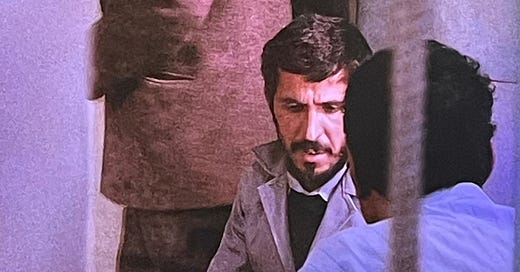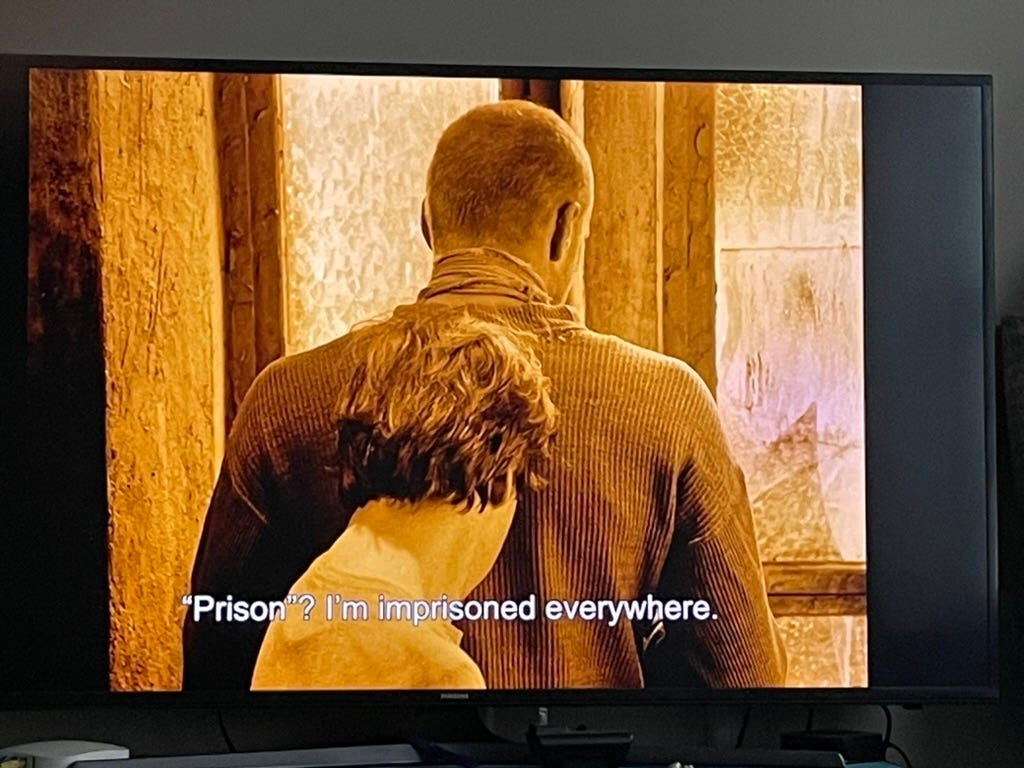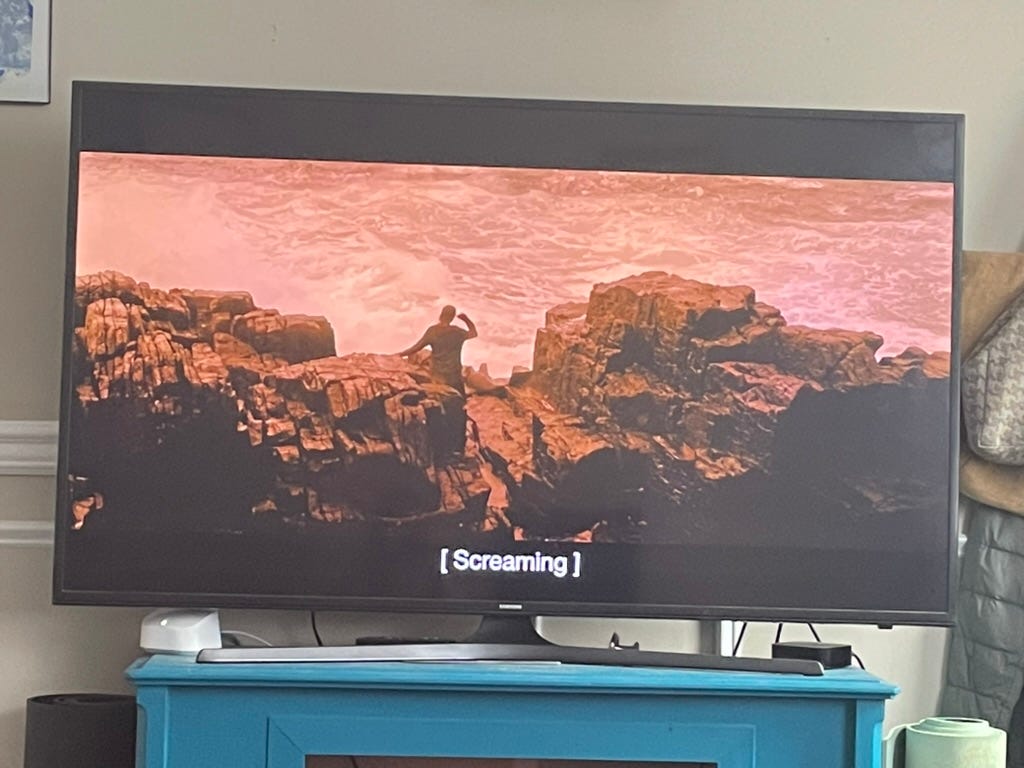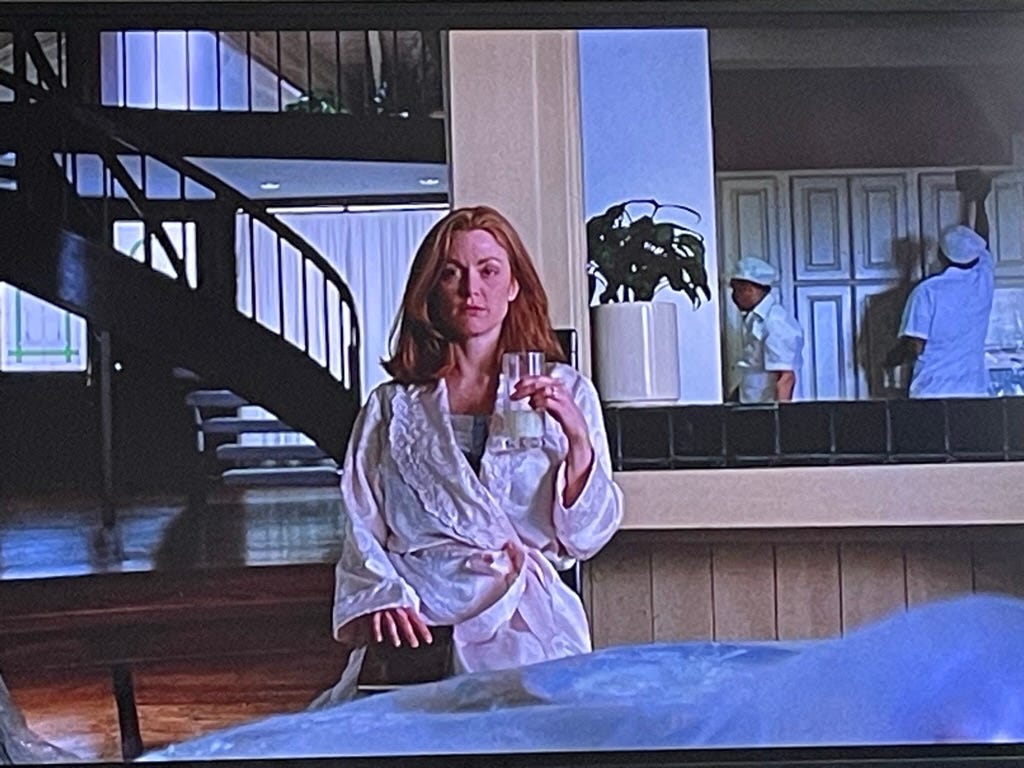(CW) Two weeks sane
DID, movies, hypervigilance, Fugazi (the band) and cake (not the band), in that order.
Hello, and thank you to everyone who reached out about, liked, commented or mentioned the last newsletter. Or even if you liked it secretly, and I don’t know that. I just feel like a ghoul sometimes, wading the waters of such heavy subject matter. As Why?’s Yoni Wolf says on their new album, “I know I’m not a carnival.” A lot of the album is saying, “Yeah, I’m a downer, thanks for putting up with me,” a message I’d like to echo here. I guess many of you didn’t grow up under carnival-producing conditions either, so perhaps we’re together in that, and that’s what it’s all about.
This month: DID, movies, hypervigilance, Fugazi (the band) and cake (not the band), in that order.
CW: Rape
Two weeks sane
I recently stumbled across the thought experiment of whether or not I could go a full two weeks without a mini mental health crisis. I would define a mini crisis as a time when my fear-based thoughts manifest into words and actions that ultimately sow chaos in my surroundings. After almost four years of hard healing work, the crises have shrunk to “mini” size, but we still experience a lot of internal changes in a relatively short amount of time, which can be destabilizing. How many changes over how short a time? Well, enough that 14 days in a row of uninterrupted sanity initially seemed a bit of a stretch.
At this current juncture, a new alter or group of alters is more “forward” or prominent in my mind every one to three days, and there are about 10 different “categories” these alters/groups fall into. That’s at least five and up to 14 changes in mood and perspective over a two week period. I sometimes look back at a period of days and feel as if I’ve been splashing in 1000 fountains. Bathing in each one with fervor anew. Frantically ferrying palmfuls of water into my gasping mouth. My pores saturated and my belly filled with that moment’s vision or viewpoint.
I know I’ve used allegory to make it sound thrilling and exotic, but ultimately it promotes a fractured, changing, unsafe version of reality rather than the shared, consistent, safe one that exists around me. It’s all about observing the gushing fountain of thoughts, feelings and memories and putting it into context. Alters do have lots of real reasons to be mad, sad, scared and confused, it’s just that most of them lie in the past, a detail that should be accounted for but isn’t always.
So why can’t I just stay here? Be present and all that. Why can’t I stay sane for just two weeks? Well, I’m going to try. I’m going to pay attention. I’m going to question my line of thinking when it turns catastrophic and unwieldy. We’re going to meet chaos with care. These thoughts will still naturally occur, but we’re focused addressing them before they progress to saying and doing, two things that make passing emotions seem more weighty and permanent. And we’re going to see how it goes, and you may or may not hear an update at the end of the experiment, because it may or may not yield anything interesting!
I finally watched Close-Up
As an art house/Criterion Collection-style movie nerd, it’s very important for me to see Close-Up, a 1990 movie by Iranian filmmaker Abbas Kiarostami. It’s extremely well-known around the world and used a unique style of a fiction-documentary hybrid where real people from a court case play themselves and live their real lives on film. The case is about a man who impersonated a famous director (that many people didn’t know what he looked like) for small personal gains (financial and emotional). To be clear, he did that in real life, and the people he fooled really did press charges. How bizarre, they should make a movie about it, and they did, and it was phenomenal, I loved it.
Learning more about older documentaries, realism and cinéma vérité and all that (when the camera is watching someone do what they would normally do and not intervening in any way), I think about reality TV and how it’s really just the same thing, produced and commodified out of its mind, but still. People are harsh about watching people “do nothing,” but watching people do nothing was revolutionary at one time, especially if it was Bob Dylan (Dont Look Back, D. A. Pennebaker, 1967). I’m sure there’s tons of scholarship on this I wouldn’t even know where to find. I personally think a Venn diagram of Bob Dylan and Kim Kardashian would be a good place to start.
I took a new screenshot for my collection of movie stills I don’t share because I think they are the most boring thing in the world to someone who hasn’t seen it, but heck, why not take up some space every now and then in my own newsletter. Contrast this to most times, when, whether you feel I’m successful or not, I deliberately try to exclude anything boring.
Like most of my screenshots, this portrays one of my ugliest traits in plain terms. “You could make a film about my suffering.” Yes, this is something I would say to a director as the impersonator guy does here. I do have a persistent need to spread news of my great suffering and make a big deal about it!
This man’s wife would like him to stop being a pseudo-spiritual guide to the mysterious “zone” because it’s illegal. However, being a black market guide guy is his one true passion in life. He scoffs when she mentions prison because prison is everywhere to him without his passion, which I find delightfully dramatic and relatable as an artist.
Is happiness enough for me? I want to say probably not, but I have the goal that one day it will be. Like the character in this film (not pictured, speaking this line to her son), this unreasonable dissatisfaction makes me a piece of work.
This is what my privileged ass has to deal with! All this pain, and all this privilege. The incongruity!
This is from a movie about a crazy woman, something I identify as but you may or may not call me depending on the context, just like all reclaimed terms. In this scene she screams into the waves that crash ashore of her small Scottish town, just like I yearn to do. The way I relate to crazy women in film is an essay I’ll write one day. You know, how you’re supposed to look at these women and think, “Wow, they’ve really lost it,” but as a crazy woman you’re forced to admit, “Yeah, I get like that, too.” But that’s representation, and we’re grateful.
And this is just Julianne Moore drinking a full-sized glass of milk like we all used to do, and I won’t ever fully get off of milk because of those days. Nowadays I drink a few sips of milk with dessert only. And tons of milk in lattes, okay, I still drink a lot of milk.
White boy check
What does hypervigilance look like four years after the abuse finally stopped but you live in the same city as before? It looks like the white boy check, a very complicated living algorithm devised to answer the question, “Did this white boy approaching the opposite way on the sidewalk rape me x years ago?”
There are a few factors at play that make this difficult to determine. First is the amount of white boys in the greater Philadelphia area who have raped me. Is it tacky to say the exact figure of how many white boys in the greater Philadelphia area have raped you? These are the questions you have to deal with as the author of All Parts Present. I mean, if you needed to transport them all at once, perhaps to prison, you could do it with a single vehicle, just don’t underestimate the size of the vehicle you’ll need. You see what I’m saying? They won’t all fit in your SUV. Do you have a commercial license?
In any case, it’s a lot of menacing faces bouncing around our memory, split between multiple alters. Meanwhile they’re all out there aging between four and 12 years and counting since I last saw them. Faces slowly sagging; head hair and facial hair growing, being trimmed; weight being gained, lost. All different parts of the check to run. It’s a lot to keep track of, and all in an instant so you can figure out if you should be on-guard or not, during which time you are certainly already on-guard.
Being automatically on-guard without present and immediate cause? Why, this is simply called hypervigilance. And it lives here. But Adam coined the “white boy check,” which I thought was a cute rebranding. Furthermore, I have ran into past abusers, or at least seen them from afar, four times in the past four years, so the fear is not totally unfounded. So to all the white boys on the other side of the sidewalk, at the coffee shop and the grocery store, yes, I am staring at you, but only because my past experiences have led me to be wary around you. Thank you for submitting to this white boy check. You’re free to go.
Cool idea from the Fugazi doc
You’ve heard that women are people, but have you heard that people are women? This is one of the points made by Ian McKaye of the innovative post-hardcore band Fugazi during a live show depicted in Jem Cohen’s 1999 documentary Instrument:
“I read in the paper the other day about some young men, some boys, who were beating up gay men in the park. Let me tell you now, I don’t give a fuck what you are, but you do not beat up people for being gay. You do not beat up people for being Black. You do not beat up people for being women. You do not beat up people period.”
Pretty standard anti-violence and anti-discrimination message (which is relevant to the sometimes-violent fans in their audience), but what I think is so interesting and even revelatory about this phrasing is that it highlights that we are all human first, not second. It’s not that queer people, people of color, women, disabled people or people of any type of oppressed group are those identities and also happen to be human. It’s the other way around.
I still catch myself thinking white men to be some sort of “neutral” or “default” human consciousness to the extent that I was shocked to hear the idea of “people” framed differently. People are women. I’ve truly never thought about it this way! I’m a people! What a relief! We have to spread the word in case people stop flocking to this Fugazi doc from 25 years ago, just trying to do my part.
Cake of the month: Masa buttermilk tres leches
Corny, tangy and sweet—how intriguing! This innovative twist on traditional tres leches comes from the brilliant Sohla El-Waylly in her cookbook Start Here. The original is a Mexican sponge cake soaked in a mixture of three milks (tres leches, in Spanish): sweetened condensed, evaporated and whole milk. Sohla adds some corn flour (masa harina) to the cake, which she has you toast in a skillet to bring out its flavor like a genius. She also uses sweetened condensed milk, buttermilk and heavy cream in her soak mixture and tops the whole thing with sweetened, whipped cream and berries.
To be honest, I’m not that familiar with tres leches in practice, so I’m not exactly sure if mine came out right or if it’s supposed to be more saturated with the milk mixture than it was. You poke a bunch of holes so it can soak in. Sponge cakes are not always my favorite as I can find them a little tough texturally, but I’m trying to make more iconic dishes of the world, and this certainly qualifies. It was good. Interesting, a worthwhile exploration. I ate some for breakfast the next morning, so you know it passed the test. That is another part of the cake of the month tradition I’m not sure I’ve mentioned. Second day cake breakfast. Classic. No one is making you be a breakfast tyrant, by the way. Have whatever you want. And with that, goodbye. Thank you.











Another great one. I like the screenshots! And people as women, something I also hadn't really considered. Laughed aloud at 'Do you have a commercial license?'